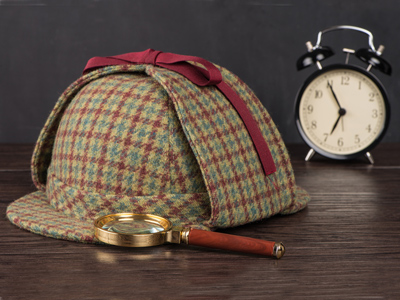
Fictional Characters - Sherlock Holmes
Sherlock Holmes is surely the greatest fictional detective of all time. Arthur Conan Doyle’s creation is the current holder of the Guinness World Record for the most portrayed literary character across film and television. Almost every person on Earth has heard of him. Millions believe he is not a fictional character but a real individual and in fact he was inspired by the real-life figure of Joseph Bell, a surgeon Conan Doyle met at the Royal Infirmary of Edinburgh in 1877.
The writer of this quiz, Tim Symonds, is the author of five Sherlock Holmes novels including ‘Sherlock Holmes And The Mystery of Einstein’s Daughter’ based on an as-yet unsolved riddle in the famous physicist’s life - what did happen to his illegitimate daughter ‘Lieserl’? As the American scientist Frederic Golden put it in Time Magazine, ‘Lieserl’s fate shadows the Einstein legend like some unsolved equation’. Find out more by visiting Tim's website.
The Club’s name seems to have been taken from Diogenes the Cynic (although this is never explained in the original stories) and was co-founded by Sherlock's indolent elder brother, Mycroft Holmes
Conan Doyle should know what Holmes was talking about. He was himself a qualified medical doctor. Incidentally, there is no such snake as an Indian ‘swamp adder’ but the name does sound frightening
The Sherlock Holmes short stories were first published in The Strand with illustrations by Sidney Paget. When ‘A Scandal in Bohemia’ appeared in the July 1891 issue circulation rose immediately. The magazine also published a United States edition from February 1891 through February 1916. With the serialisation of Doyle's The Hound of the Baskervilles between August 1901 and April 1902, sales reached their peak. Without such an outlet, the Sherlock Holmes stories may never have gained their immense popularity
A classic example is Israel Zangwill’s ‘The Big Bow Mystery’ published in 1892. Mrs Drabdump's lodger is discovered with his throat cut. There is no trace of a murder weapon and no way a murderer could have got in or out. Another is ‘The Murders in the Rue Morgue’, a short story by Edgar Allan Poe published in Graham's Magazine in 1841. A woman and her daughter are murdered in an inaccessible room, locked from the inside. And John Dickson Carr’s ‘He Who Whispers’, in which the victim is stabbed to death in a closely guarded tower. Much further back, the Old Testament story ‘Bel And The Dragon’ has some similarities to locked-room mysteries
The jezail (or Jezzail, from Pashto) was a simple, often handmade muzzle-loading long arm then commonly used in British India, Central Asia and parts of the Middle East. Incidentally, some calculations (‘economic power’) give the modern value of Watson’s wound pension as Sterling £1,652, about the same as the average wage of a factory worker in Britain today
Ready for more?
not all...
quizzers. Try to win a coveted spot on our Hall of Fame Page.








Gregory (Scotland Yard detective): "Is there any other point to which you would wish to draw my attention?"
Holmes: "To the curious incident of the dog in the night-time."
Gregory (bewildered): "The dog did nothing in the night-time."
Holmes: "That was the curious incident."